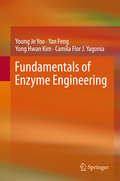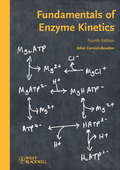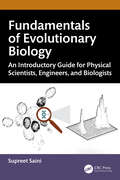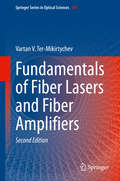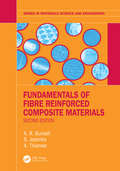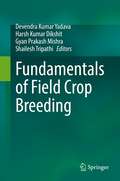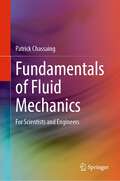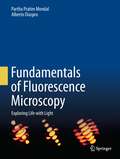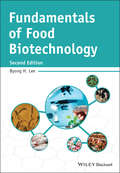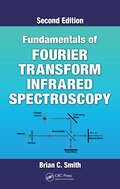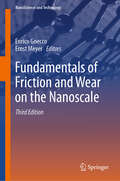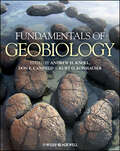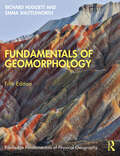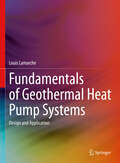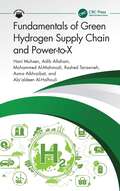- Table View
- List View
Fundamentals of Enzyme Engineering
by Young Je Yoo Yan Feng Yong-Hwan Kim Camila Flor J. YagoniaThis book provides a comprehensive introduction to all aspects of enzyme engineering, from fundamental principles through to the state-of-the-art in research and industrial applications. It begins with a brief history, describing the milestones of advancement in enzyme science and technology, before going on to cover the fundamentals of enzyme chemistry, the biosynthesis of enzymes and their production. Enzyme stability and the reaction kinetics during enzymatic reactions are presented to show how enzymes function during catalysis and the factors that affect their activity. Methods to improve enzyme performance are also presented, such as cofactor regeneration and enzyme immobilization. The book emphasizes and elaborates on the performance and characteristics of enzymes at the molecular level. Finally, the book presents recent advances in enzyme engineering and some key industrial application of enzymes addressing the present needs of society. This book presents essential information not only for undergraduate and graduate students, but also for researchers in academia and industry, providing a valuable reference for the development of commercial applications of enzyme technology.
Fundamentals of Enzyme Kinetics
by Athel Cornish-BowdenNow in its fourth edition, this textbook is one of the few titles worldwide to cover enzyme kinetics in its entire scope and the only one to include its implications for bioinformatics and systems biology. Multi-enzyme complexes and cooperativity are therefore treated in more detail than in any other textbook on the market. The respected and well known author is one of the most experienced researchers into the topic and writes with outstanding style and didactic clarity. As with the previous editions, he presents here steady-state kinetics and fast reactions, supplementing each chapter with problems and solutions. For the first time, this edition features a companion website providing all figures in colour www.wiley-vch.de/home/fundenzykinet
Fundamentals of Evolutionary Biology: An Introductory Guide for Physical Scientists, Engineers, and Biologists
by Supreet SainiEvolution is a stochastic process, and given the amount of data generated in biological sciences today, there is a pressing need for people with a quantitative background to understand and contribute toward the understanding of evolution, leading to better interaction between stakeholders. This book equips engineers and physical scientists to make biologically relevant quantitative representations of evolutionary processes. The concepts of evolution are introduced via semi-quantitative treatment with graphical illustrations and explain how evolution experiments are conducted in a laboratory.Features:• Discusses background, concepts of evolutionary biology, and experimental evolution.• Helps readers develop a geometric view of evolutionary processes.• Covers both biological and mathematical foundations in equal measure.• Illustrates coding exercises supported by pertinent MATLAB codes for the provided problems.• Includes homework problems and a solutions manual.This book is aimed at senior undergraduate and graduate students in engineering and physical sciences.
Fundamentals of Fiber Lasers and Fiber Amplifiers (Springer Series in Optical Sciences #181)
by Vartan V. Ter-MikirtychevThis book covers the fundamental aspects of fiber lasers and fiber amplifiers, and includes a wide range of material from laser physics fundamentals to state-of-the-art topics in this rapidly growing field of quantum electronics. This expanded and updated new edition includes substantial new material on nonlinear frequency conversion and Raman fiber lasers and amplifiers, as well as an expanded list of references inclusive of the recent literature in the field. Emphasis is placed on the nonlinear processes taking place in fiber lasers and amplifiers, their similarities, differences to, and their advantages over other solid-state lasers. The reader will learn the basic principles of solid-state physics and optical spectroscopy of laser active centers in fibers, the main operational laser regimes, and will receive practical recommendations and suggestions on fiber laser research, laser applications, and laser product development. The book will be useful for students, researchers, and professional physicists and engineers who work with lasers in the optical and telecommunications field, as well as those in the chemical and biological industries.
Fundamentals of Fibre Reinforced Composite Materials (Series in Materials Science and Engineering)
by A.R. Bunsell S. Joannès A. ThionnetFibre reinforced composite materials are showing sustained growth in an ever widening range of applications from food trays to spacecraft as well as contributing to resolving environmental problems, including enabling the forthcoming hydrogen economy to be realised. This second edition of Fundamentals of Fibre Reinforced Composite Materials has been fully updated throughout, providing an authoritative and modern introduction to the topic with a brief history of composite development, a review of composite applications, manufacture and markets, types of fibres and matrices used, and their properties with a detailed introduction into the computer simulation of composite behaviour. With extensive sets of sample problems accompanying each chapter, this book is ideally suited to undergraduate and graduate students of materials science, structural, mechanical, and aeronautical engineering, polymer science, metallurgy, and other courses. It will also be of use as a reference to researchers and engineers working with composite materials and material scientists in general. Features: Presents thorough discussions on composite history, composite applications and markets, types of fibres and resins used, and their respective properties Relates mathematical concepts to the structure of the material under discussion leading to the quantitative evaluation of safety factors Provides numerous sets of sample problems in each chapter
Fundamentals of Field Crop Breeding
by Harsh Kumar Dikshit Gyan Prakash Mishra Devendra Kumar Yadava Shailesh TripathiThis book is an advanced textbook and a reference book for the post-graduate plant-breeding students and the plant breeders. It consolidates fundamental concepts and also the latest advances in plant-breeding practices including development in crop genomics. It contains crop wise explanation on origin, reproduction, genetics of yield contributing traits, biotic and abiotic stresses, nutritional improvement and crop specific plant-breeding procedures and techniques. The chapters are planned to describe crop-focused breeding procedure for the major crop plants as per their economic importance. The recent developments in breeding of field crops have been reported. The recent progress made in mapping traits of economic importance has been critically reviewed for each crop. The progress made in markers assisted selected in few crops has been summarized. This book bridges the knowledge gap and bring to the researchers and students information on modern breeding tools for developing biotic and abiotic stress tolerant, climate resilient and micronutrient rich varieties of field crops. The chapters in book are contributed by experienced Plant Breeders.
Fundamentals of Fingerprint Analysis, Second Edition
by Hillary Moses DaluzBuilding on the success of the first Edition—the first pure textbook designed specifically for students on the subject—Fundamentals of Fingerprint Analysis, Second Edition provides an understanding of the historical background of fingerprint evidence, and follows it all the way through to illustrate how it is utilized in the courtroom. An essential learning tool for classes in fingerprinting and impression evidence—with each chapter building on the previous one using a pedagogical format—the book is divided into three sections. The first explains the history and theory of fingerprint analysis, fingerprint patterns and classification, and the concept of biometrics—the practice of using unique biological measurements or features to identify individuals. The second section discusses forensic light sources and physical and chemical processing methods. Section three covers fingerprint analysis with chapters on documentation, crime scene processing, fingerprint and palm print comparisons, and courtroom testimony. New coverage to this edition includes such topics as the biometrics and AFIS systems, physiology and embryology of fingerprint development in the womb, digital fingerprint record systems, new and emerging chemical reagents, varieties of fingerprint powders, and more. Fundamentals of Fingerprint Analysis, Second Edition stands as the most comprehensive introductory textbook on the market.
Fundamentals of Fluid Mechanics: For Scientists and Engineers
by Patrick ChassaingThis textbook provides a coherent and structured overview of fluid mechanics, a discipline concerned with many natural phenomena and at the very heart of the most diversified industrial applications and human activities. The balance between phenomenological analysis, physical conceptualization and mathematical formulation serve both as a unifying educational marker and as a methodological guide to the three parts of the work. The thermo-mechanical motion equations of a homogeneous single-phase fluid are established, from which flow models (perfect fluid, viscous) and motion classes (isovolume, barotropic, irrotational, etc.) are derived. Incompressible, potential flows and compressible flows, both in an isentropic evolution and shock, of an ideal inviscid fluid are addressed in the second part. The viscous fluid is the subject of the last one, with the creeping motion regime and the laminar, dynamic and thermal boundary layer. Historical perspectives are included whenever they enrich the understanding of modern concepts. Many examples, chosen for their pedagogical relevance, are dealt with in exercises.The book is intended as a teaching tool for undergraduate students, wishing to acquire a first command of fluid mechanics, as well as graduates in advanced courses and engineers in other fields, concerned with completing what is sometimes a scattered body of knowledge.
Fundamentals of Fluorescence Microscopy
by Alberto Diaspro Partha Pratim MondalThis book starts at an introductory level and leads reader to the most advanced topics in fluorescence imaging and super-resolution techniques that have enabled new developments such as nanobioimaging, multiphoton microscopy, nanometrology and nanosensors. The interdisciplinary subject of fluorescence microscopy and imaging requires complete knowledge of imaging optics and molecular physics. So, this book approaches the subject by introducing optical imaging concepts before going in more depth about advanced imaging systems and their applications. Additionally, molecular orbital theory is the important basis to present molecular physics and gain a complete understanding of light-matter interaction at the geometrical focus. The two disciplines have some overlap since light controls the molecular states of molecules and conversely, molecular states control the emitted light. These two mechanisms together determine essential imaging factors such as, molecular cross-section, Stoke shift, emission and absorption spectra, quantum yield, signal-to-noise ratio, Forster resonance energy transfer (FRET), fluorescence recovery after photobleaching (FRAP) and fluorescence lifetime. These factors form the basis of many fluorescence based devices. The book is organized into two parts. The first part deals with basics of imaging optics and its applications. The advanced part takes care of several imaging techniques and related instrumentation that are developed in the last decade pointing towards far-field diffraction unlimited imaging.
Fundamentals of Fluvial Geomorphology
by Ro CharltonFundamentals of Fluvial Geomorphology provides an accessible introduction to the study of river landforms and the processes that shape them. Rivers are significant geomorphological agents, they show an amazing diversity of form and behaviour and transfer water and sediment from the land surface to the oceans. This book examines how river systems respond to environmental change and why this understanding is needed for successful river management. Highly dynamic in nature, river channels adjust and evolve over timescales that range from hours to tens of thousands of years or more and are found in a wide range of environments. The book provides a comprehensive overview of recent developments in river channel management, clearly illustrating why an understanding of fluvial geomorphology is vital in channel preservation, environmentally sensitive design, and the restoration of degraded river channels. Fundamentals of Fluvial Geomorphology is an indispensable text for undergraduate students. It provides straightforward explanations for important concepts and mathematical formulae, backed up with conceptual diagrams and appropriate examples from around the world to show what they actually mean and why they are important.
Fundamentals of Food Biotechnology
by Byong H. LeeFood biotechnology is the application of modern biotechnological techniques to the manufacture and processing of food, for example through fermentation of food (which is the oldest biotechnological process) and food additives, as well as plant and animal cell cultures. New developments in fermentation and enzyme technological processes, molecular thermodynamics, genetic engineering, protein engineering, metabolic engineering, bioengineering, and processes involving monoclonal antibodies, nanobiotechnology and quorum sensing have introduced exciting new dimensions to food biotechnology, a burgeoning field that transcends many scientific disciplines.Fundamentals of Food Biotechnology, 2nd edition is based on the author's 25 years of experience teaching on a food biotechnology course at McGill University in Canada. The book will appeal to professional food scientists as well as graduate and advanced undergraduate students by addressing the latest exciting food biotechnology research in areas such as genetically modified foods (GMOs), bioenergy, bioplastics, functional foods/nutraceuticals, nanobiotechnology, quorum sensing and quenching. In addition, cloning techniques for bacterial and yeast enzymes are included in a "New Trends and Tools" section and selected references, questions and answers appear at the end of each chapter.This new edition has been comprehensively rewritten and restructured to reflect the new technologies, products and trends that have emerged since the original book. Many new aspects highlight the short and longer term commercial potential of food biotechnology.
Fundamentals of Forensic Biology
by Avinash Puri Nithyanandam Mahalakshmi Tanya Chauhan Alka Mishra Preeti BhatnagarThis textbook for graduate students presents fundamental and essential principles of forensic biology. It covers the theory, principles, and applications of forensic biology, focusing on the easier understanding of the applicability of the topics. It discusses the subject with an aim to enhance the theoretical and practical knowledge of the subject and explore the potentials of the fields in modern-day crime scene investigation for researchers and practitioners of the field. The book is supplemented with real-life case studies from national and international cases, significant to the discipline or unique approach to evidence analysis. Notably, the textbook discusses forensic sample analysis, emerging trends and new technologies, and legal and ethical concepts about forensic investigations. It further presents the history and development of forensic DNA profiling and the role of DNA databases in forensic investigations. It elucidates the applications of nanotechnology in forensics and examines the role of forensics in attributing acts of bioterrorism or bioproliferation.
Fundamentals of Fourier Transform Infrared Spectroscopy
by Brian C. SmithReflecting the myriad changes and advancements in the technologies involved in FTIR, particularly the development of diamond ATRs, this second edition of Fundamentals of Fourier Transform Infrared Spectroscopy has been extensively rewritten and expanded to include new topics and figures as well as updates of existing chapters. Designed for those ne
Fundamentals of Fracture Mechanics
by Tribikram KunduAlmost all books available on fracture mechanics cover the majority of topics presented in this book, and often much, much more. While great as references, this makes teaching from them more difficult because the materials are not typically presented in the order that most professors cover them in their lectures and more than half the information p
Fundamentals of Fragrance Chemistry
by Charles S. SellThis textbook provides a simplified introduction into organic chemistry, which includes separation techniques and analytical methodologies. It continues to discuss the structure of perfume creation with respect to the many reactive ingredients in consumer products and how to formulate effective and long lasting fragrances.
Fundamentals of Friction and Wear on the Nanoscale (NanoScience and Technology)
by Enrico Gnecco Ernst MeyerThis book offers a comprehensive review on the latest developments in the field of nanotribology. With contributed chapters covering instrumental aspects, theoretical models, and selected experimental results, this book provides a broad overview of the fundamental issues currently being investigated in the field. The updated third edition includes new topics such as molecular tribology, multiscale structural lubricity, tribofilm growth, nanoscale friction in liquids, and nanotribology at insect-plant interfaces. Written by a highly qualified group of international experts, this book aims to be a key reference on the subject for the next five to ten years, highlighting the importance of understanding the atomistic origins of friction and wear in everyday life and in technical applications.
Fundamentals of Gas Dynamics
by Mrinal KaushikThis textbook for courses in gas dynamics will be of interest to students and teachers in aerospace and mechanical engineering disciplines. It provides an in-depth explanation of compressible flows and ties together various concepts to build an understanding of the fundamentals of gas dynamics. The book is written in an easy to understand manner, with pedagogical aids such as chapter overviews, summaries, and descriptive and objective questions to help students evaluate their progress. The book contains example problems as well as end-of-chapter exercises. Detailed bibliographies are included at the end of each chapter to provide students with further resources. The book can be used as a core text in engineering coursework and also in professional development courses.
Fundamentals of Gas Dynamics (Ane/athena Bks.)
by V. BabuThis textbook on Fundamentals of Gas Dynamics will help students with a background in mechanical and/or aerospace engineering and practicing engineers working in the areas of aerospace propulsion and gas dynamics by providing a rigorous examination of most practical engineering problems. The book focuses both on the basics and more complex topics such as quasi one dimensional flows, oblique shock waves, Prandtl Meyer flow, flow of steam through nozzles, etc. End of chapter problems, solved illustrations and exercise problems are presented throughout the book to augment learning.^
Fundamentals of Geobiology
by Andrew H. Knoll Kurt O. Konhauser Don E. Canfield2012 PROSE Award, Earth Science: Honorable Mention For more than fifty years scientists have been concerned with the interrelationships of Earth and life. Over the past decade, however, geobiology, the name given to this interdisciplinary endeavour, has emerged as an exciting and rapidly expanding field, fuelled by advances in molecular phylogeny, a new microbial ecology made possible by the molecular revolution, increasingly sophisticated new techniques for imaging and determining chemical compositions of solids on nanometer scales, the development of non-traditional stable isotope analyses, Earth systems science and Earth system history, and accelerating exploration of other planets within and beyond our solar system.Geobiology has many faces: there is the microbial weathering of minerals, bacterial and skeletal biomineralization, the roles of autotrophic and heterotrophic metabolisms in elemental cycling, the redox history in the oceans and its relationship to evolution and the origin of life itself..This book is the first to set out a coherent set of principles that underpin geobiology, and will act as a foundational text that will speed the dissemination of those principles. The chapters have been carefully chosen to provide intellectually rich but concise summaries of key topics, and each has been written by one or more of the leading scientists in that field..Fundamentals of Geobiology is aimed at advanced undergraduates and graduates in the Earth and biological sciences, and to the growing number of scientists worldwide who have an interest in this burgeoning new discipline.Additional resources for this book can be found at: http://www.wiley.com/go/knoll/geobiology.
Fundamentals of Geomorphology
by Richard John HuggettThis extensively revised, restructured, and updated edition continues to present an engaging and comprehensive introduction to the subject, exploring the world's landforms from a broad systems perspective. It covers the basics of Earth surface forms and processes, while reflecting on the latest developments in the field. Fundamentals of Geomorphology begins with a consideration of the nature of geomorphology, process and form, history, and geomorphic systems, and moves on to discuss: structure: structural landforms associated with plate tectonics and those associated with volcanoes, impact craters, and folds, faults, and joints process and form: landforms resulting from, or influenced by, the exogenic agencies of weathering, running water, flowing ice and meltwater, ground ice and frost, the wind, and the sea; landforms developed on limestone; and landscape evolution, a discussion of ancient landforms, including palaeosurfaces, stagnant landscape features, and evolutionary aspects of landscape change. This third edition has been fully updated to include a clearer initial explanation of the nature of geomorphology, of land surface process and form, and of land-surface change over different timescales. The text has been restructured to incorporate information on geomorphic materials and processes at more suitable points in the book. Finally, historical geomorphology has been integrated throughout the text to reflect the importance of history in all aspects of geomorphology. Fundamentals of Geomorphology provides a stimulating and innovative perspective on the key topics and debates within the field of geomorphology. Written in an accessible and lively manner, it includes guides to further reading, chapter summaries, and an extensive glossary of key terms. The book is also illustrated throughout with over 200 informative diagrams and attractive photographs, all in colour.
Fundamentals of Geomorphology (Routledge Fundamentals of Physical Geography)
by Richard Huggett Emma ShuttleworthThis revised and updated edition continues to provide a comprehensive introduction to the subject, exploring the world’s landforms from a broad systems perspective. It covers the basics of Earth surface forms and processes, while reflecting on the latest developments in the field. Fundamentals of Geomorphology begins with a consideration of the nature of geomorphology, including its relation to society, process and form, history, and geomorphic systems, and moves on to discuss: • Structure: structural landforms associated with plate tectonics and those associated with volcanoes, and folds, faults, and joints. • Process and form: landforms resulting from, or influenced by, the exogenic agencies of weathering, running water, flowing ice and meltwater, ground ice and frost, the wind, and the sea; landforms developed on limestone; extraterrestrial landforms; and landscape evolution, a discussion of ancient landforms. Fundamentals of Geomorphology provides a stimulating and innovative perspective on the key topics and debates within the field of geomorphology. Written in an accessible and lively manner, it includes guides to further reading, chapter summaries, and an extensive glossary of key terms. The book is also illustrated throughout with over 200 informative diagrams and attractive photographs, all in colour. It is supported by online resources for students and instructors.
Fundamentals of Geophysical Hydrodynamics
by Boris Khesin E. B. Gledzer Felix V. Dolzhansky A. E. GledzerThis newly-translated book takes the reader from the basic principles and conservation laws of hydrodynamics to the description of general atmospheric circulation. Among the topics covered are the Kelvin, Ertel and Rossby-Obukhov invariants, quasi-geostrophic equation, thermal wind, singular Helmholtz vortices, derivation of the Navier-Stokes equation, Kolmogorov's flow, hydrodynamic stability, and geophysical boundary layers. Generalizing V. Arnold's approach to hydrodynamics, the author ingeniously brings in an analogy of Coriolis forces acting on fluid with motion of the Euler heavy top and shows how this is used in the analysis of general atmospheric circulation. This book is based on popular graduate and undergraduate courses given by F.V.Dolzhansky at the Moscow Institute of Physics and Technology, and is the result of the author's highly acclaimed work in Moscow's Laboratory of Geophysical Hydrodynamics. Each chapter is full of examples and figures, exercises and hints, motivating and illustrating both theoretical and experimental results. The exposition is comprehensive yet user-friendly in engaging and exploring the broad range of topics for students and researchers in mathematics, physics, meteorology and engineering.
Fundamentals of Geothermal Heat Pump Systems: Design and Application
by Louis LamarcheFundamentals of Geothermal Heat Pump Systems: Design and Application is written for upper-level undergraduate and graduate courses in renewable energy and heat transfer. This classroom-tested text covers ground heat exchanger modeling, secondary loop ground-source system design, pumping energy, thermal response testing, commercial building applications, and horizontal and groundwater ground heat exchangers. The book is oriented to practical applications, including the economic analysis of ground source heat pump (GSHP) systems, but more theoretical sections are provided covering research-related geothermal applications. Chapters on heat transfer fundamentals and heat pump concepts are included for readers less familiar with thermal engineering concepts. A chapter covering the economic analysis of GSHP systems is also included. All of the examples and problems in the book are solved using the open-source Python programming language.The book will provide students in geothermal energy courses with a solid understanding of the subject. It will also be a valuable reference for professionals working in the field of renewable energy.
Fundamentals of Green Hydrogen Supply Chain and Power-to-X
by Hani Muhsen Adib Allaham Mohammed Al-Mahmodi Rashed Tarawneh Asma Alkhraibat Ala’aldeen Al-HalhouliThis book offers an engaging introduction to green hydrogen and its role in changing the global energy landscape. It explains theoretical and practical aspects of the green hydrogen supply chain, including production, storage, transportation, and utilization, and explores the techno-economic aspects relevant to each stage. Through hands-on examples, readers understand how green hydrogen can be implemented across various applications. It explains Power-to-X technologies, which enable the conversion of green hydrogen into eco-friendly fuels and chemical feedstocks. Designed for students and researchers, this book simplifies complex concepts and provides a comprehensive understanding of green hydrogen's benefits.Key Features: Covers end-to-end the green hydrogen and Power-to-X technologies (PtX) supply chain. Provides a holistic and integrated approach of theoretical and practical knowledge utilizing examples and various case studies from around the world. Demonstrates the global potential of green hydrogen with sector-specific applications and case studies. Includes cutting-edge and recent developments in the green hydrogen landscape with clear visuals and technical explanations. Discusses forward-looking evaluations of Power-to-X technologies, hydrogen safety, and green hydrogen techno-economic aspects. Written in simple yet detailed language for a wide spectrum of readers. Tests readers' comprehension of the topics covered with self-assessment questions at the end of each chapter. This textbook is an excellent foundational text for university students and researchers in renewable energy engineering, energy systems engineering, chemical, environmental, and mechanical engineering, and sustainable development. It is also valuable to professionals in energy, heavy industries, and the chemical and pharmaceutical sectors, and policymakers with a focus on innovative clean, renewable energy.
Fundamentals of Guided-Wave Optoelectronic Devices
by William S. C. ChangOptoelectronic guided-wave devices are used in a wide range of optical fiber communication and optoelectronic systems. In such networks, the electrical and the optical characteristics of guided-wave devices, and the interplay between them, have a profound effect on system design and overall performance. Uniquely, this book combines both the optical and electrical behavior of guided-wave optoelectronic devices so that the interwoven properties, including interconnections to external components, are easily understood. It provides the key concepts and analytical techniques that readers can apply to current and future devices. It also presents the impact of material properties on guided-wave devices, and emphasizes the importance of time-dependent interactions between electrical and optical signals. This is an ideal reference for graduate students and researchers in electrical engineering and applied physics departments, as well as practitioners in the optoelectronics industry.
